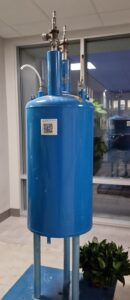Manufacturer – Bruker (Germany) 1978
Magnetic field – 4.7 T (proton resonance frequency 200 MHz)
The diameter of the warm (room temperature) opening – 89mm

The magnet was purchased in a set with a Bruker NMR spectrometer CXP-200 and installed in the NMR laboratory of the Institute of Cybernetics physics sector at Rävala pst. 10 in1978. This also marked the beginning of the era of superconducting magnets at NICBP. The spectrometer enabled the measurement of high-resolution spectra of liquids and solids both on protons at a frequency of 200MHz and on heteronuclei. On the new spectrometer the NMR research started with electromagnets was continued, but soon the magnet was replaced with an 8.5T magnet that offered higher sensitivity.
In 1982 construction of a ion cyclotron resonance (ICR) mass spectrometer based on this magnet was started, for which an ICR cell was purchased from Bruker and a high-vacuum system was established. The first work in the field of FT ICR was the precise measurement of the difference between the masses of helium-3 and tritium ions to estimate the neutrino mass, while the NMR spectrometer console was used to record and process the ICR signals. The conclusion from the analysis of the measurement results is that the mass of the neutrino does not exceed 2eV, which was considered the most accurate estimate at that time [1,2].
In 1984 the ICR system was completed with Bruker’s special CMS-47 console. The spectrometer was used to study various gas-phase ion-molecular reactions, including the characterization of protonation and deprotonation equilibria of organic acids and bases and the description of related solvation processes. The complexation between DMSO and CH 3 O – , Cl – and NO – anions was studied more thoroughly under conditions of low partial pressure (10 -7 mbar). Experiments confirmed the possibility of electrophilic solvation of anions by DMSO, which was further characterized and more precisely determined by quantum chemical calculation methods [3.4].
After the spectrometer was moved to the KBFI Mustamäe building in the mid-1990s, research based on the MALDI (matrix-assisted laser desorption/ionization) ionization method was started with the aim of increasing the accuracy of ICR in measuring the mass of organic ions with a high mass number [5.6].
By 2005, the spectrometer’s electronics and vacuum system had depreciated to such an extent that the ICR topic had to be discontinued at NICPB. The superconducting magnet also did not find further use due to the high consumption of liquid helium.